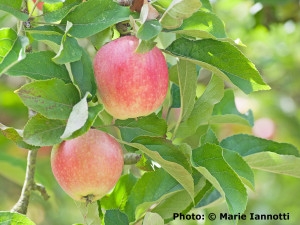- Author: Paul McCollum
To all the lovely people,
Some of our fruit trees are producing well this year but because of the water situation the fruit is a little smaller than normal. Here are some tips that may be of some help to some of you.
Paul McCollum MG04
3 Tips to Make Growing Fruit Trees Easier
As lovely as it is to be able to pluck fresh fruit off a tree in your backyard, there's no denying that fruit trees demand attention. With most fruit trees, you only get one chance at a harvest each year.
These 3 tips won't solve all your fruit tree headaches, but they will help you keep your trees healthy, which will help to keep them productive – with minimal effort from you.
Tip #1 – Protection From Below
I don't like to let the grass grow up against my fruits trees, because I don't want to damage them with the mower or string trimmer. Actually, it's unlikely I could get under some of them with the mower at all. However I also hate to leave the area unplanted. It just invites weeds and creates one more monthly chore.
I've been looking for a good choice for underplanting; something that wouldn't steal water and nutrients from the tree, wouldn't need a lot of maintenance and also wouldn't invade the lawn too badly.
I have 2 suggestions for you. The first is ginger. Either Canadian (Asarum canadense) or the glossy leaved European (Asarum europaeum).
The plants are very attractive and easy to maintain. They never need trimming and if they start to encroach on the lawn, I pull them up and move them elsewhere. They do grow best in partial shade, which my trees provide. But if your site is sunnier than mine, the second option, chives, might be better.
Alliums help to repel borers. Planting onions and garlic around fruit tree roots is not a great option, but chives are easy to plant there. They even look like lawn. They have the added benefit of repelling feeding animals, although those that climb will eventually find a way around them.
Still not convinced? Chives are also thought to improve the overall health of apple trees and aid in preventing apple scab, when grown in close proximity to apple trees.
Tip #2 – A Weed that Feeds
Don't be so quick to eradicate dandelions near your fruit trees. Dandelions don't always look attractive, but they are extremely useful plants, especially around fruit trees. For starters, they attract pollinators. Since lack of pollination is one of the chief reasons home fruit trees are not productive, we need all the help we can get. So do the bees. Dandelions are an important food source early in the season. The flowering of dandelions signals the start of honey bee season.
Dandelions also give off ethylene gas. Allowing them to bloom later in the season will encourage the fruits to get busy and ripen.
And finally, those annoying tap roots that are so hard to dig out of the ground are helping to break up dense soil and bring nutrients up toward the surface, where other plants can access them.
Tip #3 – An Easier Harvest
Dwarf fruit trees are advertised as great options for small yards and for easy harvesting, but dwarf is a relative term. Many of these trees will keep growing to 20 or more feet, and even on a ladder with a pole, I can't harvest them. While complaining that soon I wouldn't be able to prune the tops of my trees, a friend recommended an elegantly simple solution. To keep them at a manageable height, always prune them without a ladder. I prune off everything at the height I can reach. That way I am sure I'll also be able to reach the ripened fruits. The trees are small enough to care for and they still produce plenty of fruit.







